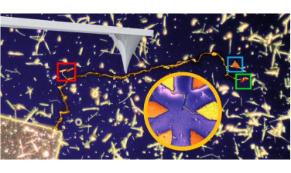Article: published in Nano Letters by Cristina Gómez-Navarro and Julio Gómez-Herrero, IFIMAC researchers and members of the Condensed Matter Physics Department.
Researchers from Universidad Autónoma de Madrid (UAM) and Instituto de Física de la Materia Condensada (IFIMAC) have developed a new technique for fabricating nanoelectrodes for the characterization of electrical transport properties at the nanoscale. They use an atomic force microscope (AFM) tip to manipulate gold nanowires (∼50 nm in diameter and 5 µm in length) and join them together by cold welding. This way they form highly conductive complex reconfigurable nanostructures, which allow the electrical connectivity and characterization of other nano-objects in a clean and simple way, since this technique does not require the use of polymers or chemicals. Therefore, this new method, called SPANC (Scanning-Probe-Assisted Nanowire Circuitry) can complement and/or be an alternative to other methods to fabricate nanocircuits.
The researchers present some examples that illustrate the capabilities of the method, which includes the manufacture of robust devices for the electrical characterization of various nano-objects with sizes down to ∼10 nm, well below the smallest nano-object size that can be contacted in a device-type configuration with the currently available standard technology (∼30 nm). Among others, there are examples of electrical characterization of different materials such as graphite, carbon nanotubes or antimonene; different measurement configurations, such as an electrode of gold nanowires (with a conductive AFM tip as a second mobile electrode) and more conventional devices of 2 and 4 gold nanowire electrodes; or their introduction in the field of molecular electronics, studying the electrical transport properties of 1,4benzenedithiol molecules.
The results of this work represent a significant advance in the miniaturization of electrical circuits through a simple and versatile procedure that can be combined with other manufacturing techniques. [Full article]


